| Eleanor Alice Burford Hibbert | Home | Jean Plaidy Titles |
| Norman Series | Plantagenet Series | Tudor Series | Stuart Series | Georgian Series | Queen Victoria Series | Queens of England Series | Trilogies, Italy, France and Spain | Other Titles |
| Trilogies, Italy, France and Spain |
Lucrezia Borgia

Madonna of the Seven Hills Vol. 1
1958, Robert Hale
This is the story of Lucrezia Borgia, born into history's most notorious family. Her father, who became Pope Alexander VI, was known as the 'most carnal man of his age'.
Growing from childhood into beautiful womanhood, Lucrezia becomes aware of that destiny from which, as a Borgia, she could not hope to escape...
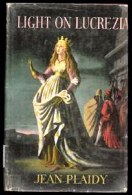
Light on Lucrezia Vol. 2
December 1958, Robert Hale
The continuing story of Lucrezia Borgia, a beautiful woman caught up in a tortuous web of fear and love.
With her handsome husband Alfonso, Lucrezia hoped for happiness . . . but faced with brutal murder she becomes torn between her love for her husband and her devotion to her brother Cesare.
Lucrezia Borgia
May 20, 1976, Robert Hale
The one volume version of Madonna of the Seven Hills and Light on Lucrezia.
No family is more notorious than the Borgias. During their lives they proved a source of scandal which has not abated over five centuries. In this compelling novel Jean Plaidy tells of the rise of Rogerigo Borgia to the death of his daughter Lucrezia. It is a tale of passion, intrigue and murder such as has rarely, if ever, occurred before or since. Lucrezia was born into fifteenth century Rome, her background the jewelled splendour of the Papal Court. Here she grew up with her family - Roderigo, her father, who became Pope Alexander VI and was known as the 'most carnal man of his age' and his mistress, Vannozza Catenei, who became the mother of his children Cesare, Giovanni and Lucrezia. This is a frank story of the brutal days of the Borgias when the whole of Italy trembled at the sign of the Grazing Bull, when every man feared to sup at the Borgia table, when the Pope and his son dreamed of a united Italy under their rule and a bewildered young girl was caught up in a web of fear and love.
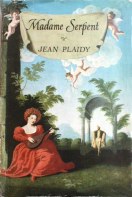
Madame Serpent Vol. 1
1951, Robert Hale
As a fourteen-year-old Catherine de' Medici rode into France. Behind her and before her rode the nobility of Italy. She was to marry Henry of Orleans, second son of the King.
Amid the glittering fetes, masques, jousts and banquets of the immoral court in 16th century Europe, the reluctant bride became a passionate but unwanted wife.
Angry, humiliated and tortured by jealousy as she secretly spied on Henry's lovemaking, Catherine began to plan her revenge...

Italian Woman Vol. 2
1952, Robert Hale
No longer humiliated and neglected, Catherine de' Medici, the Italian Woman, was free to seek revenge. Henry II of France was dead and she was Queen Regent.
Mother of Kings, her sons were tainted in mind and body: Sickly Francis, devoted to Mary, the lovely Queen of Scots; Charles, subjected to bouts of madness; Henry, handsome and perverted. For them she would scheme and kill.
As Catherine plotted to hold the balance of power between Catholic and Protestant, the word Italian became synonymous with Poisoner...

Queen Jezebel Vol. 3
1957, Robert Hale
August 24th, 1572 - Madness seized Catholic Paris. The cobbles were stained with Huguenot blood. The carnival of butchery begun by the bell of Saint Germain l'Auxerrois raged unchecked.
To her other crimes Catherine de' Medici now added the infamy of St. Bartholomew's Eve. Worshipping no god save power she lived only to rule through her tainted offspring.
None of her children - mad Charles, perverted Anjou, deformed Alencon, or the wanton Margot - trusted the Queen Mother. None loved her. And all France feared her.
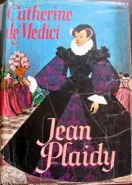
Catherine de’Medici Vol. 1,2,3
January 1969, Robert Hale
The one volume edition of Madame Serpent, The Italian Woman, and Queen Jezebel.

Evergreen Gallant
1965, Robert Hale
From the time he was fifteen, women found Henry of Navarre irresistible. But he was never faithful for long. marked for death by a Catholic count who saw in him the rallying point of Huguenot fortunes, Henry took his pleasures where he found them.
A father at fifteen, he was sent to become a soldier under the great Coligny but still found time for love affairs. Yet when his mother died mysteriously, he began to change, and the man who rode to Paris to play the part of bridegroom in the "Blood-Red Wedding" was alert for treachery. Facing death nonchalantly, accepting the Mass in exchange for his life, amusing himself with the mistress who he knew had been sent to spy on him, he deluded even Catherine de' Medici.
Life with the tempestuous Margot was like a succession of farcical incidents from Decameron. Reputed to have more mistresses than any King of France, he passed lightly from one to another. There were the spies of Catherine de' Medici, promiscuous Charlotte de Sauves, and gentle Dayelle; Fosseuse, who came into conflict with Margot; Corisande, whom he loved as a wife; Gabrielle, who had been sold to a King and others by her rapacious mother; Henriette, with the acid tongue; these and others occupied him until the day of his death when he was pursuing the youthful Charlotte de Montmorency.
In addition to his mistresses, there were two wives to plague him: Flamboyant Margot, whose adventures rivaled his own, and Marie de'Medici, who came to torment his later years.
This was the man who, affectionately known as the Evergreen Gallant because all through his life he was in love with some woman, brought prosperity back to a war-scarred country, declared Paris to be worthy a Mass, and was recognized as the greatest King the French had ever known.

Louis, the Well-Beloved Vol. 1
December 1959, Robert Hale
The people wanted to see their Louis free of doddering ministers, King in his own right, bringing back glory to France and prosperity to their hearths.
But Louis cared only for the thrills of hunting and gambling, the excitements of war, until even these paled before the sensual delights offered by a succession of mistresses - from beautiful waiting women to the celebrated Marquise de Pompadour.
This glittering picture of the ancient regime mirrors the early years of Louis XV - and the women who ruled the King.

Road to Compiegne Vol. 2
1959, Robert Hale
Wars, riots, religious dissension, the enmity of Parliament, the intrigues of the Dauphin, and the hunger of his people left Louis XV unmoved.
No longer the Well-Beloved, he ignored the dangers facing France seeking refuge from any unpleasantness in extravagance, folly and undisguised sensuality.
After the death of Madame de Pompadour, a succession of lovely girls brought Louis temporary forgetfulness until the voluptuous du Barry made the King once again feel young and gay and in love...

Flaunting Extravagant Queen Vol. 3
1957, Robert Hale
At the age of fifteen, Marie Antoinette, beautiful and charming bride to the impotent Dauphin, is plunged into the intrigue of Versailles.
Frivolous and reckless, she flouts the strict and demanding etiquette of the glittering court, and discovers the true mature of hate . . . and love.
But the clouds of revolution are overhead, and Marie Antoinette, who only wished to enjoy life, learns too late that the price of her enjoyment is very high...

Castile for Isabella Vol. 1
1960, Robert Hale
With fifteenth-century Spain rent with intrigue and threatened by civil war, Isabella became the pawn of her ambitious, half-crazed mother and a virtual prisoner at the licentious court of her half-brother, Henry IV.
Was she, at sixteen, fated to be the victim of the Queen's revenge, the Archbishop's ambition and the lust of Don Pedro Giron, one of the most notorious lechers in Castile?
Numbed with grief and fear, Isabella yet remained steadfast in her determination to marry Ferdinand, the handsome young Prince of Aragon, her only true betrothed...
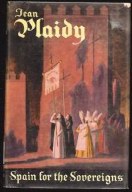
Spain for the Sovereigns Vol. 2
1960 Robert Hale
Married to Ferdinand after continual fears and disappointments, Isabella triumphed over every danger, convinced of her true destiny.
With the might of Portugal humbled, the Court of the Sovereigns saw the rise of Torquemada, the establishment of the dreaded Inquisition, and the coming of Columbus who left the woman he loved to make a dream reality.
Ambitious and unfaithful, Ferdinand longed to lead his troops against the Moorish strongholds. Isabella knew a united Spain and a glorious future could be theirs, but they must only share it together...

Daughters of Spain Vol. 3
1961 Robert Hale
With Spain now united, Ferdinand looked to his daughters to further his ambitions. All too often, Isabella found herself torn between his brilliant plans and her love for her children. During the last years of Isabella's reign it seemed there was a curse on the Royal House which struck at the children of the Sovereigns.
Tragedy followed tragedy - the infanta Isabella, a brokenhearted widow; Juana, driven to madness by her husband's philandering; and the sorrow of parting with young Catalina, destined to become Katharine of Aragon, wife to Henry VIII and Queen of England...

Isabella and Ferdinand Vol. 1,2,3
1970, Robert Hale
The one volume edition of Castile for Isabella, Spain for the Sovereigns, and Daughters of Spain

The Rise of the Spanish Inquisition Vol. 1
June 1, 1959, Robert Hale
Jean Plaidy, with all her novelist's perception and skill, tells the story of Ferdinand and Isabella, the monarchs who brought the Inquisition into Spain in the fifteenth- century, and allowed it to flourish so hideously.
Isabella was a pious and fervent Catholic who detested the corrupt decadence of her brother's court at Castile : when she came to power she was determined to stamp Spain irrevocably with the
mark of her faith.
The Inquisitors from Rome brought torture, humiliation and a fiery death to thousands - arid swelled the coffers of the state with the confiscated riches of their victims. But when Isabella's confessor, the remorseless Tomas de Torquemada, became Inquisitor General, a new era of terror began, more extreme and more ruthless than all that had gone before . . ..

The Growth of the Spanish Inquisition Vol. 2
1960, Robert Hale
The second volume of Jean Plaidy's compelling trilogy on the Spanish Inquisition charts the life of a man more powerful and more merciless even than Tomas de Torquemada, father of the Inquisition; Ximenes.
Ximenes was an ascetic, a stern man of God who had scourged his own flesh and had no sympathy for the suffering of others. When Isabella made him Archbishop of Toledo and Primate of Spain in 1945, the way was clear for him to call his bigotry virtue and persecute the Jews, perpetrating hideous acts of inhumanity in the name of God.
But when Isabella died, and her mad daughter Juana became Queen of Castile, it was Ximenes who steered Spain through a time of crisis and uncertainty.
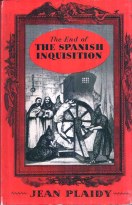
The End of the Spanish Inquisition Vol. 3
1961, Robert Hale
The Inquisition was first established in 1232. It was slow to spread to Spain, yet flourished there as nowhere else. Under Isabella it took firm root. During the next half century it grew exceedingly. But it was the reign of Philip II which enabled it to dominate the country. And the fervent desire of that Monarch was to extend the persecution of heretics into all his dominions.
In the Netherlands, Alva set up the notorious Council of Blood, and those who clung to their opinions were tortured and often burned or buried alive. Attempts were also made to establish the Inquisition in Peru, Naples, Sicily, Sardinia, Milan, the Canaries, Portugal and Goa - with varying success.
But the coming of the Bourbons saw the first real check to the Inquisitors' power. Charles III's long reign brought a new stability and an atmosphere in which bigotry could not flourish so effectively. The Inquisition started on its slow decline.
Meanwhile its toll had been terrible. Among its victims had been Antonio Peréz, whose intrusion into the emotional life of Philip II and the Princess of Eboli is still a matter for speculation; Olivares, who had tried to destroy the Inquisition; 17th century Louis Ramé, who left an account of his sufferings for posterity; English sailors such as John Drake and Richard Hawkins; William Gardiner, who was slowly roasted alive in Lisbon; the martyrs of the Netherlands; and the tragic Moors.
As in the two earlier volumes of this comprehensive study, Miss Plaidy's method is to examine the characters of those responsible for the monstrous tyranny and those who suffered because of it, and to portray it through their stories.

The Spanish Inquisition Vol. 1,2,3
June 1, 1979, Robert Hale
The one volume version of the three Spanish Inquisition novels.




Rodrigo Borgia Cesare Borgia Lucrezia Borgia Alfonso d'Este
(1431-1503) (1476–1507) (1480-1514) (1486-1534)


Catherine de'Medici Henry of Orleans
(1519-1589) (?-1559)




Margot Henry of Navarre Marie de'Medici Henriette d’Entragues
(1553-1615) (1553-1610) (1573-1642) (1579-1633)




Madame du Barry Louis XV Madame Pompadour Marie Antoinette
(1743-1793) (1710-1774) (1721-1764) (1755-1793)


Isabella Ferdinand
(1451-1504) (1452-1516)
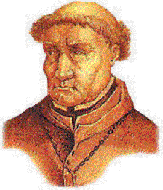
Tomas de Torquemada
(1420-1498)